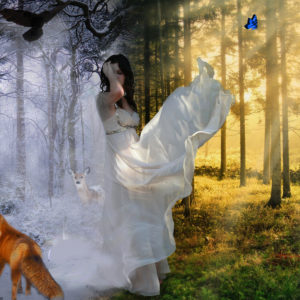Vampires had been around for centuries before Polidori. Blood sucking, flesh-eating and energy draining creatures populate the myths of world, from India to the Americas. In Babylon, the Seven Spirits were “ … a consortium of blood-quaffing demon gods…” (Frost 5). Many were female, not male. Lillitu made her appearance in Babylon and was adopted as Lillith in Hebrew mythology (Summers 198). Her appearance as succubus remained a common feature in European lore for centuries (200). In the Americas, vampiric creatures populated the Aztec world and in recent years the Chupacabra has feasted in places as far apart as Puerto Rico and Russia. Kali and the Rakshasas have struck fear into the hearts of the people of India for centuries and the obayifu has drank the blood of Ashanti children for equally as long (Summers 228).
This literature changed the face of vampires and essentially created a new being. While Dracula retains the ability to terrify and horrify, he also is an elegant and sexually appealing creature. There are no grave cloths or smells of decay. Dracula also is no longer bound by place, being able to move from country to country, place to place, as long as he brings his native soil with him. Gone are the restrictions of location and this new freedom, combined with freedom from death adds a new lethal charm and earnest danger to the character.

Le Vampire by Burne-Jones, 1897. In art, the female vampire seems to have remained a popular subject.
Vampires seem to carry the fears most relevant in society at the time of writing. The period Stoker wrote in, was one of tremendous contradiction – incredible leaps forward in science and technology were matched by depths of poverty, illness and dehumanization in factory life. Appearing at the end of the colonial era, Count Dracula posed many threats to Victorian social, moral and political values. He represented the stranger, the foreigner who invades England and threatens its superiority. He represented the fear of regression, a reversal of evolution, a return to our more primal animal state, just as we thought we had evolved. He caused doubt in the scientific, evolutionary attitude of the Western men who pursue him. As Van Helsing says “Do you not think that there are things which you cannot understand, and yet which are;…it is the fault of our science that it wants to explain all; and if it explain not, then it says there is nothing to explain,” (Stoker 304). Worst of all, Dracula changes virtuous women into voluptuous beings with ravenous sexual appetites. “… the bloodstained voluptuous mouth…the whole carnal and unspiritual appearance, seeming like a devilish mockery of Lucy’s sweet purity” (Stoker 341).
The portrayal of the vampire as an aristocrat who is immortal as long as he drinks blood, links together the concepts of the well-to-do, blue-blooded nobility and the desire for long life. The vampire has been changed from one who is simply feared to one who is both desired and feared. Aristocratic without necessarily being noble, immortal and hence endlessly sexual, the vampire is an ambiguous creature, awakening the desires that society represses.
The transformation of vampires continues in the characters of Edward Cullen in Twilight (2006) and in the vampires in A Touch of Dead (2009) by Charlaine Harris. The Twilight (2006) Cullens, a vampire family, no longer drink human blood, except when there is no other choice. They befriend humans and protect them. They even are capable of loving humans as the relationship between Bella and Edward shows. In this series, it is Bella who desires to be made into a vampire and Edward who refuses her requests. She is the instigator of sexual involvement and Edward, the vampire, is too moral to agree to it. It is a classic tale of unconsummated love but also a reversal of the usual male/female roles and of the vampiric character. Yet it is he who holds the power of transformation and it is Bella who waits determinedly.
These new vampires are a far cry from Dracula and an even further cry from the stinky revenants of European folklore. Suddenly the vampire isn’t inherently evil. He is like us, struggling to survive, to make good decisions, to love and be loved. He is no longer the polar opposite of good. Instead he embodies the internal struggle of good versus evil. Like us, the vampire needs to face the inner darkness. This newfound struggle makes the vampire a sympathetic character, elevating the archetype from one-dimensional villain to multi- dimensional hero. The vampire seeks to understand the darker side of his nature. Like us, the vampire has become aware of inner dynamics and psychological processes.
Is this a good thing? Perhaps. Maybe it is a sign that we have begun to accept our own complexities and no longer are satisfied a simple understanding of apparent evil. Maybe it is a sign we have begun to hold our projections closer, that we understand ourselves better. But I wonder at the loss of the female vampires. Modern vampires remain, for the main part male. And although female vampires still exist in the halls of fiction, as Rice shows in The Queen of the Damned, the suave aristocrat holds the larger and more moral part. It looks like we still have work to do on integrating the dark feminine.
Works Cited
Frost, Brian J. The Monster with a Thousand Faces: Guises of the Vampire in Myth and Literature. Bowling Green: Bowling Green State UP. 1989. Print.
Harris, Charlaine. A Touch of Dead (Sookie Stackhouse: The Complete Stories). New York: Penguin, 2009. Print.
Meyers, Stephanie. Twilight. New York: Little Brown and Co., 2005. Print.
Rice, Anne. The Vampire Chronicles Collection: Volume 1. New York: Ballantine Books, 2002. Print.
Stevenson, Jay. The Complete Idiots Guide to Vampires. Indianapolis: Alpha Books, 2002. Stoker, Bram. Dracula. Plain Label Books, 2002. Web. URL <http://www.books.google.com>
Summers, Augustus Montague. The Vampire : His Kith and Kin. Forgotten Books, 2008. URL www.forgottenbooks.org. Web.






